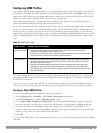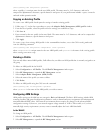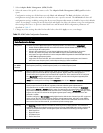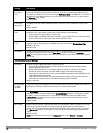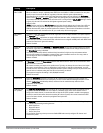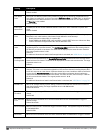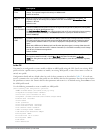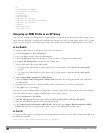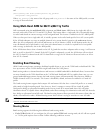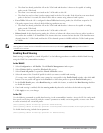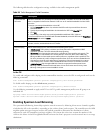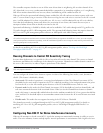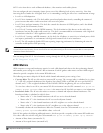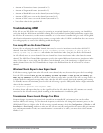
arm-profile <arm_profile>
and
(host)(config) #rf dot11g-radio-profile <ap_profile>
arm-profile <arm_profile>
Where <ap_profile> is the name of the AP group, and <arm_profile> is the name of the ARM profile you want
to assign to that radio band.
Using Multi-Band ARM for 802.11a/802.11g Traffic
Dell recommends using the multi-band ARM assignment and Mode Aware ARM feature for single-radio APs in
networks with traffic in the 802.11a and 802.11g bands. This feature allows a single-radio AP to dynamically change
its radio bands based on current coverage on the configured band. This feature is enabled via the AP's ARM profile.
When you first provision a single-radio AP, it initially operates in the radio band specified in its AP system profile.
If the AP finds adequate coverage on multiple channels in its current band of operation, the mode-aware feature
allows the AP to temporarily turn itself off and become an AP Air Monitor (APM). In AP Monitor mode, the AP
scans all channels across both bands to verify that each channel meets or exceeds its required level of acceptable
radio coverage (as defined by the in the ARM profile).
If the AP Monitor detects that a channel on the 802.11g band does not have adequate radio coverage, it will convert
back to an AP on that 802.11 channel. If the 802.11g band is adequately covered, the AP Monitor will next check
the 802.11a band. If a channel on the 802.11a band lacks coverage, the AP Monitor will convert back to an AP on
that 802.11a channel.
Enabling Band Steering
ARM’s band steering feature encourages dual-band capable clients to stay on the 5GHz band on dual-band APs. This
frees up resources on the 2.4GHz band for single band clients like VoIP phones.
Band steering reduces co-channel interference and increases available bandwidth for dual-band clients, because there
are more channels on the 5GHz band than on the 2.4GHz band. Dual-band 802.11n-capable clients may see even
greater bandwidth improvements, because the band steering feature will automatically select between 40MHz or
20MHz channels in 802.11n networks. This feature is disabled by default, and must be enabled in a Virtual AP
profile.
The band steering feature supports both campus APs and remote APs that have a virtual AP profile set to tunnel,
split-tunnel or bridge forwarding mode. Note, however, that if a campus or remote AP has virtual AP profiles
configured in bridge or split-tunnel forwarding mode
but no virtual AP in tunnel mode
, those APs will gather
information about 5G-capable clients independently and will not exchange this information with other APs that also
have bridge or split-tunnel virtual APs only. The band steering feature will not proactively disconnect clients that are
already associated with a radio. All band steering occurs when a client is trying to associate to a new AP radio.
NOTE: Best practices is to use either the Band Steering or the Spectrum Load Balancing feature to balance client load across
channels, but not both at the same time.
Steering Modes
Band steering supports the following three different band steering modes.
l Prefer-5GHz
(Default)
: If you configure the AP to use prefer-5GHz band steering mode, the AP will not respond
to 2.4 Ghz probe requests from a client if all the following conditions are met.
DellPowerConnectW-SeriesArubaOS6.2 | User Guide AdaptiveRadioManagement (ARM) | 356



